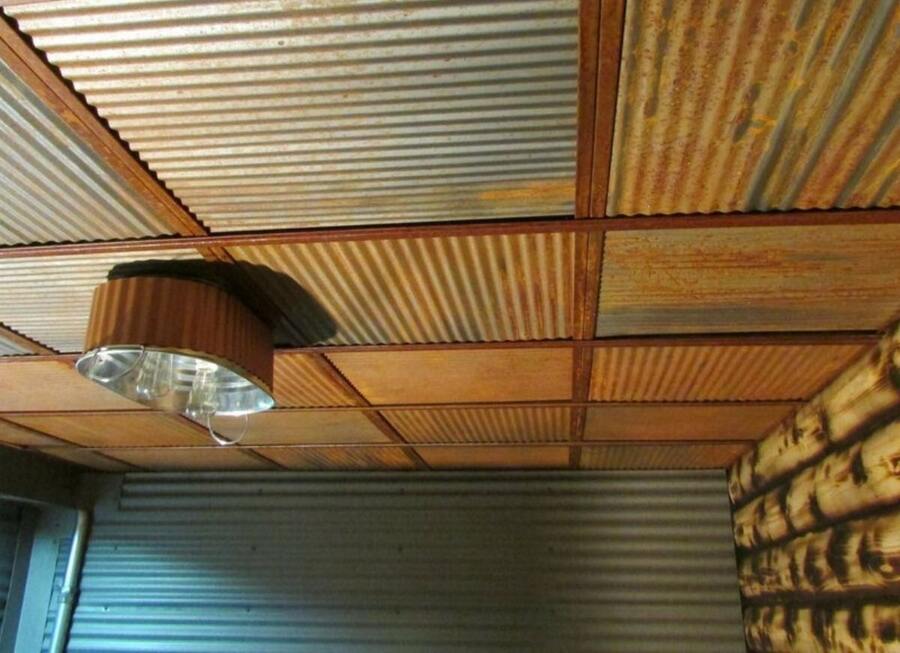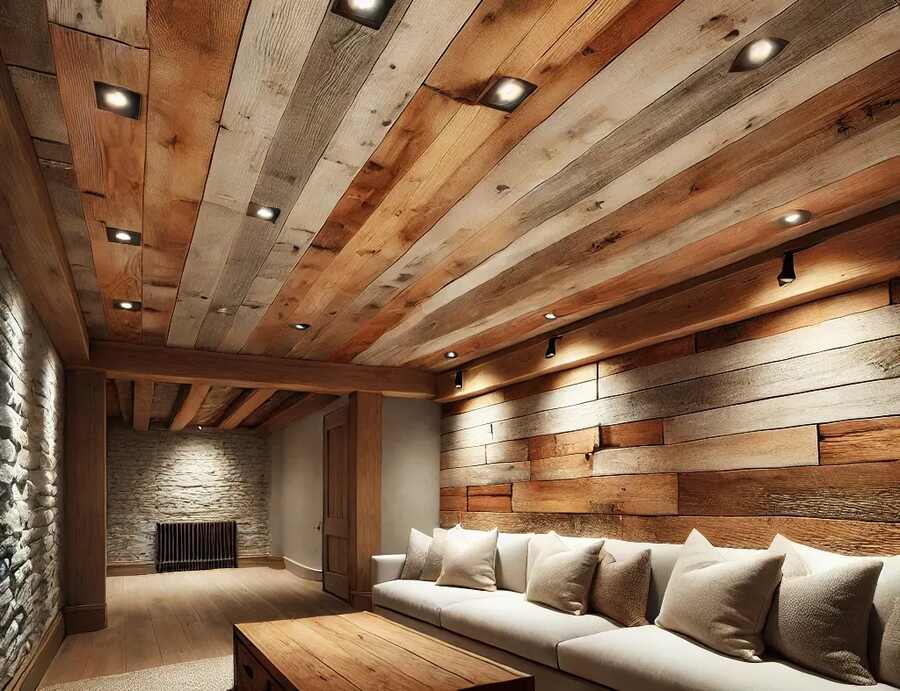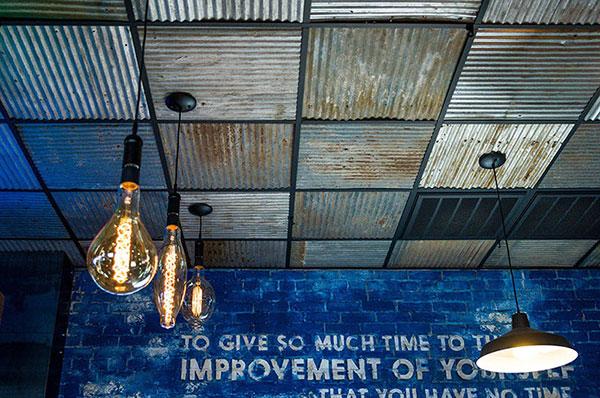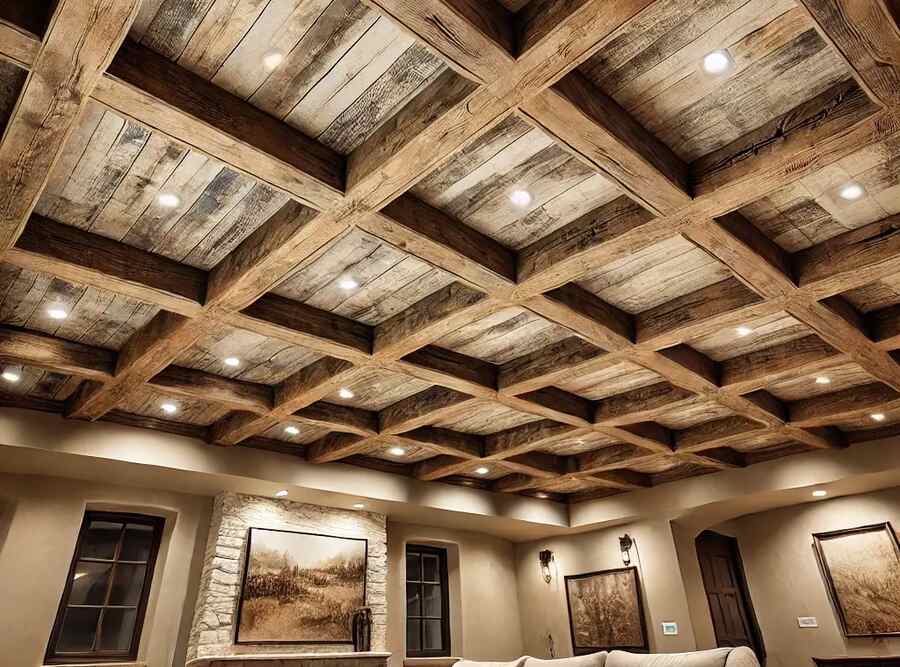Transforming a basement into a stylish and functional living space often begins with reimagining the ceiling. Once considered unfinished and uninviting, exposed basement ceilings have become a popular design choice for homeowners seeking a rustic, industrial, or modern aesthetic. The raw, unrefined look of exposed beams, ductwork, and piping adds character and depth to a room, turning what was once a hidden element into a central design feature.
This article explores various rustic exposed basement ceiling ideas, offering inspiration and practical tips to help you transform your space into a unique and inviting retreat. From reclaimed wood beams to industrial metal pipes, the possibilities are endless, allowing you to tailor the design to your style and the overall theme of your home.
What is a Rustic Exposed Basement Ceiling?
A rustic exposed basement ceiling refers to a design style where the structural elements of a basement ceiling, such as beams, pipes, and ductwork, are intentionally left visible instead of being covered. This approach emphasizes a raw and unfinished look, often incorporating natural materials like wood and metal to enhance its authenticity. The rustic style celebrates imperfections like rough textures and exposed edges, adding character and a unique aesthetic to the space. This design choice not only creates an industrial or vintage charm but also contributes to a more spacious feeling by maintaining an open and airy environment in the basement.
10 Rustic Exposed Basement Ceiling Ideas
1. Wooden Beams Paired with Industrial-Style Lighting Fixtures
Warm wood beams/industrial lights I love this mix of styles. The metal parts add a rustic touch and contrast with the natural wood in perfect harmony. The beamed ceiling adds lots of texture to the area, practically turning it into a beautiful feature wall that makes people look up. You may go for an authentic look or stain it and paint it with your prior decor.

2. Use Reclaimed Wood Panels to Add a Touch of History
Reclaimed wood is a sustainable option that will add character to your basement. Old wood panels or the weathered effect of this old style are everything your roof needs to stand out while making it feel comfortable and inviting. The reclaimed wood, another piece of history by nature, brings its own story to each addition. Cover the whole ceiling in these panels, or use them sparingly to create a rustic basement.

3. Painted Exposed Pipes Idea as a Unique Design Element
There is nothing wrong with exposing the pipes. Neon pipes in the basement are becoming intentional highlight pieces. This way, you can appreciate the factory charms of your cellar and give it a more modern feel in a rustic style. While the painted pipes can complement your home’s decor, it will be a beautiful statement piece.

4. Tin Ceiling Tiles for a Vintage Rustic Look
If you want something that looks like it could have been photographed at a Pub, tin ceiling tiles are the answer. They provide a gloss and texture touch but also maintain part of the natural look. After all, these tiles are commonly available in ornate patterns that could give your basement the good looks it desperately needs. Tin ceiling tile was installed in low-ceiling basement rooms for the added reflective surface to bounce light around, opening up these dark, gloomy, dungeon-like spaces.

5. Barnwood Planks for a Cozy Farmhouse Feel
Barnwood planks give your ceiling a rustic, farmhouse feel that’s hard to beat. The aged look of barn wood, rich textures, and natural imperfections can transform your basement into a cozy retreat. You can install the planks in a straight pattern for a clean look or arrange them in a herringbone or chevron pattern for added visual interest. The warmth of Barnwood pairs beautifully with other rustic elements like stone walls or vintage furniture, creating a cohesive design that’s inviting and timeless.

6. Open Joists with Edison Bulbs for an Rustic Vibe
Exposing the joists and pairing them with Edison bulbs can create a stunning, rustic-industrial look. It’s a raw and refined style, perfect if you want your basement to have that incredible, loft-like feel. The exposed joists give the appearance of a higher room, giving off openness and space, while similarly, the lamplight adds a cozy, effortless feel. These two pairs are fantastic together—perfect for people who love the clean lines of an industrial look but want something a little warmer and rustic.

7. Corrugated Metal Panels for an Edgy Industrial Rustic Design
While it may seem unusual, corrugated metal panels can add flavor to your ceiling. The metal plays against the industrial vibe of these pendants, while the rustic finish keeps it down to earth. If you are looking for an edgy, modern, rustic design with your basement, look no further to figure out how! These allow the metal to take on a dynamic texture, contributing to this feeling of vitality from our first point while basking in light with that metallic sheen and making your space feel slightly lighter.

8. Woven Rattan Panels for a Natural Rustic Touch
Woven rattan panels are ideal for a softer, more organic look. The natural texture and warmth they bring into your basement make it feel like a cozy hideaway. The rattan also gives the area an excellent, comfortable factor (rattan even looks good with other natural products like timber and rock). The panels allow you to cover the ceiling or create an accent for particular sections, providing complete freedom when designing your rustic area.

9. Exposed Brick Walls Combined with Wooden Beams
This reasonably simple design will make the room rustic yet elegant, attuning to be combined with brick walls and wooden beams. This is the best time to use a classic: black and white. Nothing makes your basement feel more like an urban chic loft. The rich textures of the brick and wood complement each other, adding depth and warmth to the room. This combination works particularly well in basements with high ceilings, where the beams can make a dramatic statement.

10. Faux Rustic Finishes for Easy and Affordable Rustic Charm
Use faux finishes for a touch of rustic appeal that plays well even if you have no structural elements to expose. There are faux wooden beams and plaster finishes that appear like dry-aged wood and stone, so you get the rustic look without all the work. These finishes are also a less expensive option and much easier to install than the real thing. They also let you create a rustic look in basements where they might not naturally fit with the original structure.

FAQs
What Types of Materials Are Best for a Rustic Exposed Ceiling?
Materials like reclaimed wood, tin tiles, and corrugated metal are ideal for a rustic exposed ceiling. They bring texture, and war is a critical element of the rustic style.
Can I Achieve a Rustic Exposed Ceiling in a Basement With Low Ceilings?
Yes, you can! Opt for lighter wood tones or whitewashed finishes to keep the space from feeling cramped. Using low-profile lighting can also help maintain the illusion of height.
How Can I Add Warmth to a Rustic, Exposed Basement Ceiling?
Adding warmth can be as simple as choosing a wood with warm undertones or incorporating soft lighting. Edison bulbs or vintage-style lanterns can add a warm glow that complements the rustic aesthetic.
How Can I Hide or Integrate Ductwork and Pipes Into a Rustic Exposed Ceiling?
One way to integrate ductwork and pipes is by painting them in complementary colours. Alternatively, you can wrap them in wood or corrugated metal to blend them into the ceiling design.
What Are Good Ideas for Lighting a Rustic Exposed Basement Ceiling?
I recommend using a mix of ambient and task lighting. Edison bulbs, track lighting, and industrial-style fixtures work well with the rustic aesthetic. Be sure to highlight critical areas without overwhelming the space.
What Are Some Cost-effective Ways to Achieve a Rustic Exposed Ceiling?
If you’re on a budget, consider using faux materials like faux wood beams or reclaimed wood paneling. Painting existing structural elements in a rustic color palette can also be a cost-effective solution.
What Are the Safety Considerations for a Rustic Exposed Basement Ceiling?
When exposing structural elements, ensure that electrical work, ductwork, or piping is up to code. It’s also essential to address any insulation needs, especially in a colder climate.
Conclusion
Creating a rustic exposed basement ceiling is all about embracing the natural elements and adding your personal touch. Whether using reclaimed wood, exposing beams, or integrating metal panels, keeping the design authentic to your style is critical.
I’ve found that this type of ceiling adds character and makes the basement feel like an extension of the home rather than just an afterthought. I’d love to hear from you—what ideas are you considering for your basement ceiling? Share your thoughts, and let’s get creative together!
Read Next: 10 Trendy Modern Interior Corrugated Metal Ceiling Ideas

